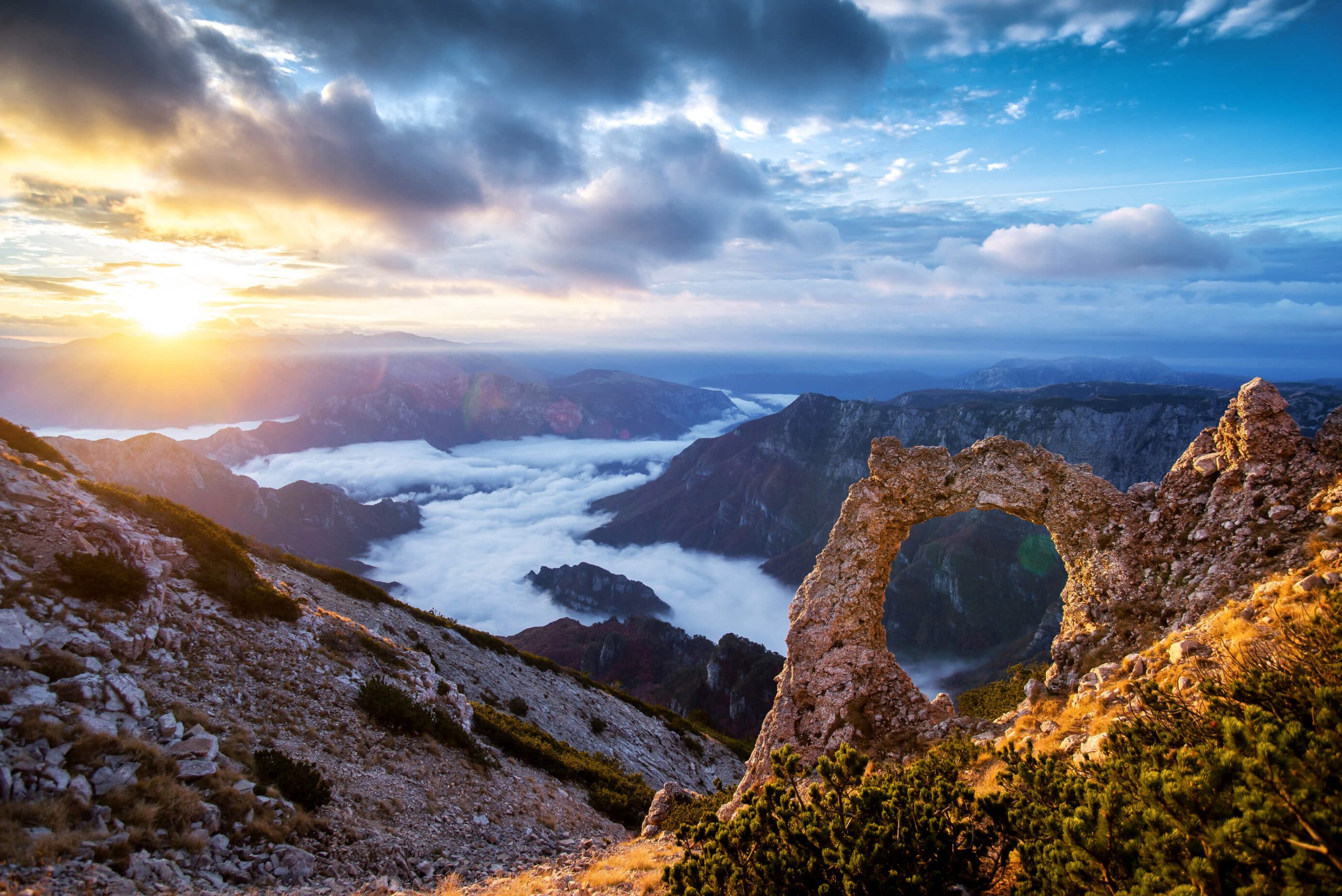
Flora and fauna
Home
Flora and fauna
22/02/2024• •
FLORA NATURE PARK BLIDINJE
In Blidinje Nature Park, there has always been an abundance of a diverse range of flora and fauna. The rich flora content of the park consists of a great diversity of plants, from Mediterranean to high-mountain species, among which there are many endemics from fungi. The beauty of the park – Bosnian pine, which has the largest complex in the whole of Europe in the park, is located in Masna Luka. Among the numerous animals of the park, the forest king – brown bear, stands out as a special feature, alongside the chamois which decorate the peaks of the Čvrsnica mountain.
Forest vegetation
The lower forest area of Blidinje is dominated by karst forests of hornbeam (lat. Carpinus orientalis) with the endemic Tilovina (lat. Petteria ramentacea), which has great biological and economic significance. Tilovina is an endemic of the karst region, rare in the flora of Bosnia and Herzegovina and important in beekeeping due to its honey-bearing properties. Beside the hemlock forests, there are oak forests (lat. Quercus pubescens). They are characterized by a high degree of diversity, and among them we find the enemic taxa Lillium cattanie and Crocus dalmaticus.
In mountain forests we find beech (lat. Fagetum montane), the most economically and floristically important forest community. A large part of endemic, relict and sensitive species was recorded in the fir community (lat. Avieti fagetum). In the southern and western parts of Čvrsnica and in the east and southeast of Vrana, as a result of postglacial zonation, we found a special system of coniferous zonation. Among them, it is important to single out the pine (lat. (Pinus heldreichii var. leucodermis), a relict, Balkan-Apennine endemic
In the montane vegetation belt, there is a beech forest (Fagetum montane) – one of the most economically important and floristically richest forest communities, unlike the subalpine beech forest community (Fagetum subalpinum) which develops in somewhat less favorable habitat conditions and with lower floristic diversity. In the montane vegetation belt, there is also a beech and fir forest community (Abieti – Fagetum), also among the richest forest communities, which includes a large proportion of endemic, relict and sensitive taxa of Bosnia and Herzegovina, such as the sensitive taxa Lilium martagon. Black pine (Pinus nigra) forest communities develop at slightly higher altitudes and represent the remains of old, more widely distributed, preglacial forests. They are characterized by a large proportion of relict taxa in the floristic composition, and on the southern and western slopes of the Ävrsnica and in the east and southeast of Vran, as a result of postglacial zonation, they form a special system of coniferous zonation. Of the forest taxa, it is particularly important to single out the munika (Pinus heldreichii var. leucodermis) – a relict, Balkan-Apennine endemic. In the center of the park in Masna Luka is the munika reserve, which is the largest such complex in Europe.
Non-forest vegetation
Mountain grasslands and ravines constitute primary natural and secondary anthropogenic communities dominated by grasses and sedges. A large number of plant species that inhabit these habitats of extreme ecological conditions are rare, endemic and relict taxa, which constitute an important gene pool of this park. Its inhabitants have had a great influence on the rich and diverse vegetation of this area. For centuries, they have cleared forests, carried out agricultural activities and fertilized these areas with their livestock, all activities that affect biodiversity. New plant varieties have also been brought to the nature park under the influence of humans. In the vegetation of wet grasslands located in the lowland of the park in the karst fields, we find endemic taxa Chouardia litardierei and Edraianthus dalmaticus. On the other hand, in dry meadows and rocky areas, which are influenced by the sub-Mediterranean climate, the endemic species Sternbergia colchiciflora var. dalmatica occurs.
In the mountain forests, we find beech (lat. Fagetum montane), the most economically and floristically important forest community. A large part of endemic, relict and sensitive species was recorded in the fir community (lat. Avieti fagetum). In the southern and western parts of Čvrsnica and in the east and southeast of Vrana, as a result of postglacial zonation, we found a special system of coniferous zonation. Among them, it is important to single out the pine (lat. (Pinus heldreichii var. leucodermis), a relict, Balkan-Apennine endemic
In the montane vegetation belt, there is a beech forest (Fagetum montane) – one of the most economically important and floristically richest forest communities, unlike the subalpine beech forest community (Fagetum subalpinum) which develops in somewhat less favorable habitat conditions and with lower floristic diversity. In the montane vegetation belt, there is also a beech and fir forest community (Abieti – Fagetum), also among the richest forest communities, which includes a large proportion of endemic, relict and sensitive taxa of Bosnia and Herzegovina, such as the sensitive taxa Lilium martagon. Black pine (Pinus nigra) forest communities develop at slightly higher altitudes and represent the remains of old, more widely distributed, preglacial forests. They are characterized by a large proportion of relict taxa in the floristic composition, and on the southern and western slopes of the Ävrsnica and in the east and southeast of Vran, as a result of postglacial zonation, they form a special system of coniferous zonation. Of the forest taxa, it is particularly important to single out the munika (Pinus heldreichii var. leucodermis) – a relict, Balkan-Apennine endemic. In the center of the park in Masna Luka is the munika reserve, which is the largest such complex in Europe.
Plant species of the park
Heartwort natural brandy
Gentiana lutea L. Gentianaceae) is a very important plant of Blidinje. It is the most sought-after and popular medicinal plant among the people. It is found in mountain ravines on carbonates, forest edges, most often in the subalpine vegetation zone. The flowers are yellow, the stem is erect and grows from 50-150cm high. It is a very bitter plant.BEAR-HEAD
Alpine bear-heaven (Arctostaphylos alpinus) is a deciduous shrub from the heather family. The branches are slender and creeping, the bark is dark brown, and the fruits are round, fleshy smooth berries, red when ripe. It is called bear’s berry or bear’s grape because bears supposedly like to eat it. Bear’s berry can be found on the highest peaks on limestone rocks, and is very rare in the Dinarides.FRAJNOV CARNFIL
Freynov carnation or Freynov klinček (lat. Dianthus freynii Vandas) is originally endemic to the Herzegovina karst, from the Caryophillaceae family. It can be found at altitudes of 1900-2228m above sea level. This stenoendemic can be found on Čvrsnica.RUNOLIST
Edelweiss (lat. Leontopodium), a genus of perennials from the Compositae family to which about 60 species belong. Mountain or karst edelweiss grows in the area of Herzegovina. Its habitat is mountain ores and cracks in carbonate rocks. It is a symbol of the mountains and is a very attractive plant.PRENJSKA OSTRICA
Prenjska osivnica or Prenjska osvitnica (lat. Oxytropis prenja) is a plant of the Papilionaceae family – legumes. This endemic is widespread throughout the Dinarid Mountains, in the highest zone of Herzegovina’s high mountains, which are made of limestone rocks (from about 1900-2228m above sea level.HERZEGOVÁK ZVONČIĆ
Herzegovinian bluebell (lat. Campanula hercegovina) is a plant of the Campanulaceae family. we find them in the crevices of vertical shaded limestone rocks, at an average of 1150-1500m (interestingly, in the canyon of Diva Grabovice it is located at 240m above sea level). This endemic is known from the following locations: Neretva canyon, Rakitnica, Diva Grabovice, Drežnica and mountains: Prenj, Čvrsnica, Čabulja, Plasa and Velež.MOUNTAIN CENTURY
Mountain yarrow (lat. Achillea abrotanoides) is a herbaceous perennial flowering plant from the yarrow family. It can most often be found in the subalpine region on calcareous syrosems, among rocky blocks or on screes. It is found in ranges of 1200-2000m above sea level. This plant is also called Hajdučka trava or kunica, and is a popular medicinal plant for making teas or brandies.GREAT-FLOWERED DHAVOZJAK
Graceful Dhavozjak (lat. Doronicum grandiflorum) is a perennial herbaceous plant from the yarrow family. It can grow up to 150cm tall. Its habitat is rocky terrain around snowfields in sinkholes and the subalpine and alpine belt.SPRING UNDERGROUND
Spring crocus or Saffron (lat. Crocus neapolitanus), a perennial plant genus with an underground tuber from the Iridaceae family. Saffron was used by the ancient Greeks, Egyptians and Romans as a spice and a means for dyeing textiles and walls. It is found in deciduous and mixed forests and thickets, along forest edges and in meadows. It grows in fresh, nutritious places.ILLYRIAN CAT
Illyrian cat or Illyrian gladiolus (lat. Gladiolus illyricus) is a bulbous perennial from the iris family. Over 280 species grow in parts of Eurasia and Africa. Its habitats are dry rocky pastures from lowlands to the mountainous vegetation zone.BOSNIAN IRIDESCENT
Bosnian iris (lat. Iris reichenbachii) is a plant from the Iridaceae family (iris) and is endemic to Bosnia and Herzegovina. It is a perennial and tall plant. It is found singly or in large numbers. It usually inhabits dry meadows and pastures on carbonate and serpentinite rocks, with shallow skeletoid soil.Magical landscapes of Blidinje Nature Park
Association “Visit Blidinje”
+387 63 428 308
info@visit-blidinje.com
Masna Luka bb
88 245 Rakitno, Posušje, BiH
ID broj : 4272375500005
Raiffeisen Bank d.d. 1610000125610064
